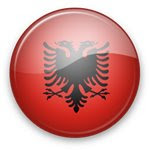The beginning of Illyrian civilization
The first indications of Illyrian civilisation go back to the end of the third millennium BC, ceramic articles being the most common. First there are vases with two handles rising higher than the neck. During the Bronze Age, burials gained in solemnity, and the first tumuli appeared, the tombs often embellished with a rich funeral dressing. The popularity of tools, armour and ornaments made of bronze brought certain increase to metallurgy. Nature had a hand in this as the country was fairly rich in minerals. Social differences became accentuated, a wealthy social class and a tribal aristocracy emerged in Illyrian society. On the Maliq site among other discoveries were bronze knifes and a bronze scythe belonging to the Aegean civilization of the sixteenth century BC. We have very cause to believe that these objects, as well as a number of knifes of Mycenaean origin discovered in the tumuli at Pazhok and Vajza, reached southern Illyria via exchanges with Greece.
At the end of the Bronze Age, and especially in the first part of the Iron Age, which is chronological with the first millennium BC, the Illyrians embarked on a new stage of their economic ,social and cultural growth. The ancient cities ,the fortified tribal centers and places of refuge for the surrounding population in case of war, were generally found on the tops of the hills or mountings, or along valleys, or beside roads where they held a dominant position. These cities were to protected by thick walls, constructed with huge, rough or slightly hewn stones. These early fortresses, which varied by their size and according to the shape of the enclosure, had no towers yet and their gates were narrow. The really old fortress of Gaitan (in Shkodra region in northern Albania) is an excellent example.
The funeral trappings discovered in the two burial necropolis at Mati especially and at Kuci i Zi (In the Korce Region) are particularly important for the information they give of Illyrian civilization in the first part of Iron Age.
A large quantity of iron armors has been retrieved-swords, daggers, kandjars, knives. Armor used in self-defense by wealthy soldiers-helmets, daggers, and bronze leg-shields are plentiful. The jewels found in abundance in the woman's tombs are also made of bronze: fibulae, buttons, pendants on chains, bracelets, pins and diadems .The arms and ornaments found in the tombs were made by high-reputed master iron-workers of the Pirustae tribe, who lived in this rich mining region. From the first part of the Iron Age the civilization in southern Illyria had its own physical features, which distinguished it from neighboring civilizations.
Very little in known about the language of Illyrians. We still have not found inscriptions or documents written in this language .There are only a few rare inscription in a Messapian dialect which was spoken in southern Italy. The only evidence of ancient Illyrian are a few names or places or people or a few isolated words ,accompanied by their meaning, reported by Ancient writers. According to linguists, the Illyrian language belonged to the Indo-European group. Illyrian was a language in common use, while Greek and Latin, the latter in particular, were only used as commercial, administrative and epigraphic languages. In certain cases, to complete the Latin alphabet, the Illyrians used their own characters, apparently to reproduce the sounds which were peculiar to their own language.
Illyria was a vast country; so its regions naturally presented various geographic and climatic conditions which determined the development of various sectors of economy activity. In areas rich in minerals, jobs associated with the extraction of treatment of metals grew in number.
The warm, coastal regions, as Strabo wrote, were covered in vineyards and olive groves. The Illyrians from the southern regions were famous animal breeders, and their oxen and sheep were admired even outside Illyria. According to ancient writers Illyrians were characterized by their honesty and hospitality. Among others, Demosthenes, Diodorus of Sicily and Nicolaus of Damas tell us that the Illyrians held nothing dearer than liberty and that they never let their wounded fall into the hands of the enemy-they were ready to sacrifice their lives to defend their friends and those near to them. These authors praised their virtues as soldiers.
Not much is known about Illyrian religion during the first part of the Iron Age.
Like all primitive people, they adored everything which seemed extraordinary in nature, particularly the sun. The symbol of the sun -an empty or solid circle- is often found on pieces of Illyrian craftsmanship. Since the Illyrians had no real sculpture when their race began, and since the functions of a large number of their divinities were very similar to those of the Greek deities, they gave their gods the physiognomy and attributes of the corresponding Greek gods. So the god of the waters and forest -the Thana of the northern Illyrian regions- was linked to the Greek Artemis then later to the Roman Diana.
The same occurred with the main god of Parthinians who figures in effigy form on the bronze coin of Dyrrachium (today Durres) and Shkodra; the Greek colonists gave him the name of Zeus, with whom he shared similar characteristic and functions. But for the Illyrians these divines were the Diana of the Candavia tribe and the Jupiter of the Parthinians, and they should not of course be confused with the Roman Jupiter and Diana. Apart from these similarities, inscriptions have revealed the names of a large number of Illyrian gods. Besides Medaure, god of war, we also find Bonus, god of spring and woods, Latra, Sentona, Vidosa and many others.

Nema komentara:
Objavi komentar